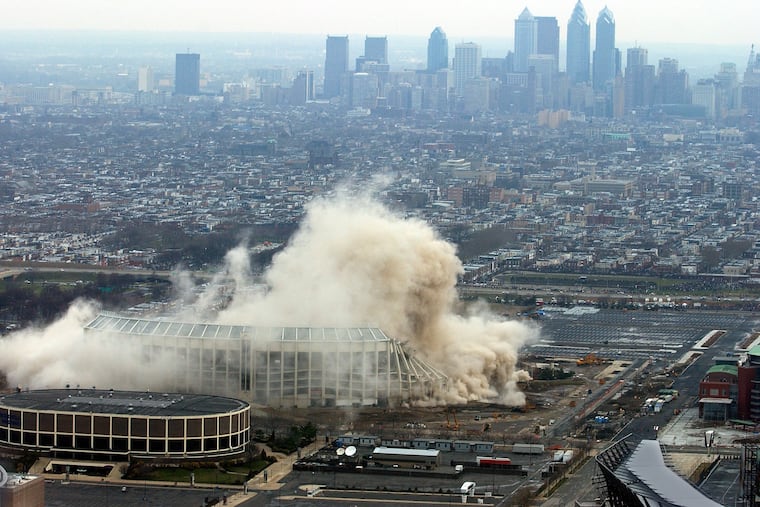Meet the man who blew up Veterans Stadium 20 years ago
Mayor Street and the Bull were decoys. Nick Peetros is actually responsible for imploding the Vet — and helping build Citizens Bank Park.

Editor’s note: This story has been updated to add that Frank Bardonaro was part of the demolition process.
Around this time of the year, Nick Peetros still can feel the hairs on his arms raise slightly. Goosebumps tend to hit him like a Zack Wheeler fastball zipping from the mound to home plate.
Twenty years ago — March 21, 2004 — Peetros was tasked with controlling the detonator button that imploded Veterans Stadium.
“I look back now and I didn’t realize it at the time, how lucky I really was,” Peetros told The Inquirer.
Around the time of the Vet’s demolition, Peetros — who grew up in Broomall and graduated from Drexel — worked for L.F. Driscoll Co., which also was tasked with the construction of Citizens Bank Park.
“It was a pretty amazing time,” said Peetros, who works as a senior estimator at Clemens Construction Co. in Philadelphia. “It was just incredibly busy. You didn’t really have a lot of time to think about it. When I look back, I am just extremely fortunate to have been at the right place at the right time. I get mixed feelings. A lot of people were supportive, but there were people that were upset about the Vet being demolished. They were big fans of it.”
For the uninitiated, the Vet, which opened in 1971 and housed the Eagles through the 2002 season and the Phillies through 2003, was located at the northeast corner of Broad Street and Pattison Avenue. A multipurpose stadium, it could hold more than 65,000 fans for football and north of 56,000 for baseball. It’s also where the Phillies clinched their first World Series title in 1980 with a victory in Game 6 over the Kansas City Royals.
» READ MORE: See photos of the Vet throughout the years, from groundbreaking to implosion
The gritty stadium, feared for its fans as much as its concrete-like playing surface, was one of a kind. The 700 Level became legendary for its rowdy crowds, with enough fights that the Vet eventually had its own courtroom and judge in the bowels of the stadium.
Last year, The Inquirer revealed another chapter through its reporting that has complicated the Vet’s legacy. Through investigative research, it was discovered the Vet used an artificial turf created with dangerous chemicals, and six former Phillies died from the same brain cancer, glioblastoma.
Whenever Peetros, 51, reflects on his moment in Philadelphia sports history, he recalls two of the favorite days of his construction career: the Vet’s implosion and Citizens Bank Park’s opening day.
“It’s pretty cool and I’m known as the guy who pushed the button amongst my friends and family,” Peetros said. “They all say, ‘I can’t believe I know the guy that blew up the Vet!’ … And I say, ‘Yeah, I can’t believe it was me.’ ”
» READ MORE: Take a trip back inside the last game at the Vet, 20 years later
At this point, your memory might be telling you something different.
That’s because on the day of the Vet’s implosion, then-Mayor John Street and former Phillies outfielder and World Series champion Greg Luzinski were publicly shown as the button-pushers of the dummy detonator — although “the Bull” was the only one to actually push it.
But behind the scenes, it was Peetros who effectively sent the Vet tumbling into rubble. The moment was documented on a History Channel program that showed Frank Bardonaro pressing the “charge” button, and Peetros manning the “fire” button. The implosion lasted 62 seconds and was witnessed by thousands of fans and representatives from the Eagles and Phillies.
As the dust settled, a new beginning for Philadelphia pro sports was rising.
A few weeks later, Citizens Bank Park opened on April 12, 2004, with the Phillies hosting the Cincinnati Reds (the Reds won, 4-1). Lincoln Financial Field, the Eagles’ new home, hosted its first regular-season game on Sept. 8, 2003.
“It’s definitely something I’m very proud of,” Peetros said. “My kids [Alex, 23; Emily, 21; Nico, 10] think it’s very cool. [Demolition] is something I’ve wanted to do in my career since I was a teenager. I spent all that time leading up to the Vet’s implosion. But I also take pride in my hometown Phillies playing in a ballpark that I was blessed to work on. It’s something I’ll never forget.”